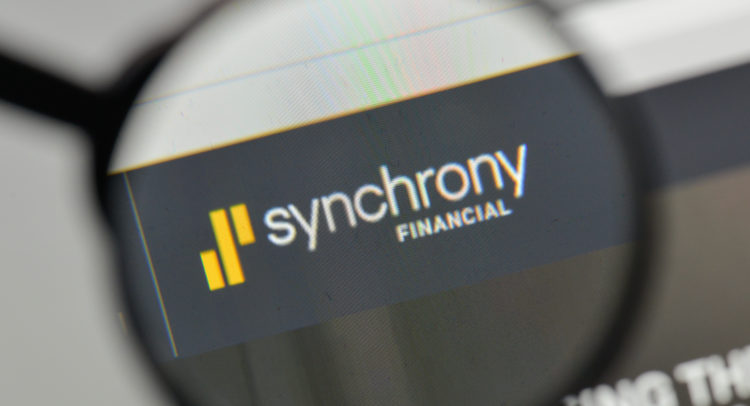Before the breakout of the coronavirus pandemic, Synchrony Financial (SYF) outperformed the S&P by a single-digit percentage following its spin-off from General Electric (GE) to become a stand-alone business.
However, now shares of the US credit-card issuer lag the broader indexes by a wide margin.
While the company’s retail card business presents a better risk profile than in previous years, this particular segment also introduces a double-edged sword.
On one hand, it fuels a net interest margin (NIM) far above that of the average bank. On the other hand, economic conditions play a greater role in the company’s fortunes as demonstrated by Synchrony’s heavy exposure to retail, which has been mauled by the coronavirus.
The Evolution Of Synchrony
In 2008, 39% of Synchrony’s borrowers held a FICO credit score below 660. Today only 23% of the firm’s credit card holders have subprime credit.
The number of locations where the company offers credit products grew from 338,000 in 2014 to 440,000 today. Purchase volume also increased from approximately $103 billion to $139 billion, and the number of active accounts expanded from 64.3 million to 68.5 million.
This growth occurred despite the pandemic and the 2018 loss of the Walmart (WMT) credit card program, which accounted for 13% of Synchrony’s receivables.
Prior to the pandemic, Synchrony recorded impressive annual increases in revenue and EPS.
Strengths And Weaknesses
Synchrony relies on a handful of retail card partners. Gap (GPS), JCPenny, Lowe’s (LOW), PayPal (PYPL) and Sam’s Club accounted for 51% of the company’s total interest and fees on loans and 47% of loans receivables in 2020.
The firm’s retail card agreements generally last five to ten years. Eleven of the current 25 agreements expire before 2025. However, the 14 partnerships that expire in 2025 or later comprise nearly 90% of the company’s annual interest and fees on loans.
Another concern is the firm’s delinquency rate. The latest results pegged the 30-plus day delinquency rate at 3.07% versus 4.44% last year. The 90-plus day delinquency rate is at 1.40% compared to 2.15% last year.
However, Synchrony had a pandemic-related forbearance program in effect until December. Additionally, the bank’s credit card delinquency rate, at 3.2% in January, exceeds the average major bank’s delinquency rate of 2.12%.
Management forecasts a peak in delinquencies in Q3 2021, and the bank has set aside a massive amount of funds for loss provisions.
Where Synchrony shines is in the company’s net interest margin (a key measure of a bank’s profitability). Despite a coronavirus related hit, it’s NIM is still near 15%. In contrast, the average US bank earned a NIM of 2.8% in 2020.
The company is also shareholder friendly. Aside from the well-funded dividend, Synchrony has a $1.6 billion share repurchase program representing 7% of its market cap coming into effect in 2021.
Prior share repurchase programs have retired a significant percentage of the company’s stock.
What Does Wall Street Think?
Consensus among Wall Street analysts for SYF is a Strong Buy based on 10 Buy ratings and 1 Hold rating. The average analyst price target of $44.80 implies upside potential of around 15% from current levels over the next 12 months. (See Synchrony stock analysis on TipRanks)

Bottom Line
The real positives for the company are an industry leading NIM and Synchrony’s history of strong growth. The primary concerns are the company’s exposure to retail and its client concentration.
However, there is one more weight to be added to the scale.
Over the last year, US bank deposits increased by nearly $3 trillion, the equivalent of four years of average savings growth. Meanwhile, credit card debt dropped by 14%, reaching a four-year low.
Although 2021 will likely bring increased credit card delinquency rates, the surge in savings and positive trends in consumer debt should mute these to a certain extent.
Despite COVID-19 headwinds, Synchrony generated nearly $1.4 billion in net income, management instituted a robust share repurchase program, and the dividend is well covered.
Furthermore, Synchrony has a forward PE ratio of 7.90 and a forward PEG ratio of 0.35. These metrics imply that Synchrony’s current valuation could provide a reasonable margin of safety and might be an investment worthy of consideration.
Disclosure: On the date of publication, Charles Walston did not have (either directly or indirectly) any positions in the securities mentioned in this article.
Disclaimer: The information contained herein is for informational purposes only. Nothing in this article should be taken as a solicitation to purchase or sell securities.

